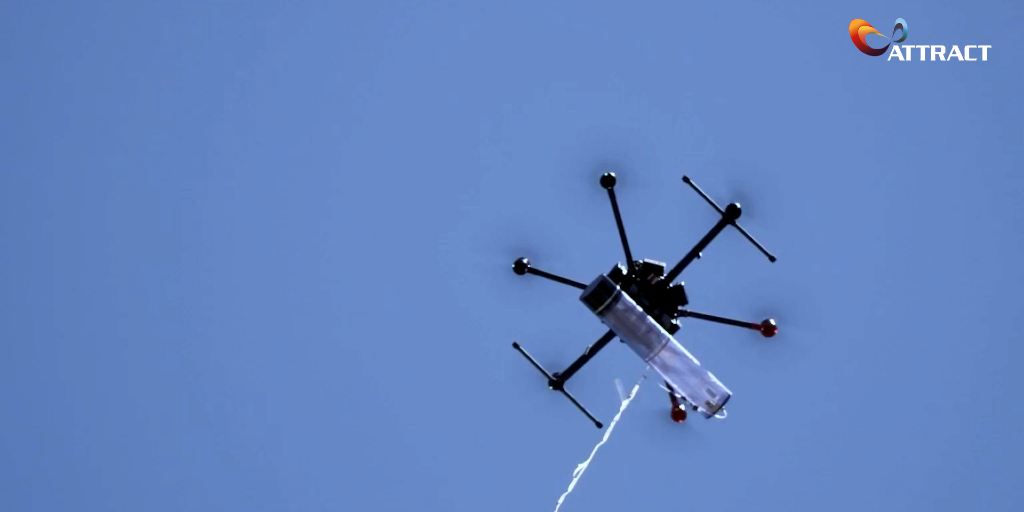The h-cube project aims at developing a ready-for-the-market, room-temperature hyperspectral camera for far infrared electromagnetic radiation. It emerged as a response to the growing demand for affordable and portable hyperspectral imaging solutions in the terahertz (THz) region of the electromagnetic spectrum. Despite the vast potential of THz waves in fields like health, security, and agriculture, practical applications have long been hindered by challenges inherent to this frequency range.
Based on the achievements of previous ATTRACT phase 1 projects like GRANT, ROTOR, and TACTICS, h-cube brings together a consortium of scientists dedicated to overcoming the challenges of THz imaging. By leveraging synergies and innovations from these initiatives, the goal of h-cube is to produce a THz sensor for hyperspectral imaging with unparalleled sensitivity and a wide THz response range, all while maintaining affordability.
Discover more about it in our interview with Alessandro Pitanti, researcher at the Istituto Nanoscienze Consiglio Nazionale delle Ricerche (CNR Istituto Nanoscienze) and coordinator of the h-cube project.
What is your personal and career journey so far?
I’m a physicist. I graduated in Pisa, and I did my PhD in Trento. After that, I moved back to Pisa for a postdoc, but very soon I left, I wanted to see a bit of what’s around the world. And I moved to Caltech for a couple of years as a Marie Curie fellow. After that, I went back to Pisa, and I started doing research at the National Research Council where I am nowadays. On top of that these days, I’m a visiting scientist at the Paul Drude Institute in Berlin.
What is the project about? And which partners are involved?
In this project, we are trying to build a Terahertz camera for the infrared range of light with a special feature that we call hyperspectral sensibility. It means that it can give you a coloured image like the same concept we have for RGB in traditional cameras. We are working on this project with several partners: the National Research Council, the University of Salerno, Fondazione Bruno Kessler, and Elettra Sincrotrone Trieste in Italy, the University of Eastern Finland, and then RECENDT in Austria, TeraVil from Lithuania. And finally, Asteria Business Development from Cambridge, UK.
What challenges have you faced so far?
As scientists, we face everyday technical and scientific challenges in our research, but in this particular project, since we are trying to get a product for the market, we need to face different challenges. So, our device cannot simply work, it needs to work reliably, it cannot be too cumbersome, and it cannot be too expensive. It needs to be tailored to the market needs. And so, these are all different challenges we are facing, we are learning quite a lot and it’s been a very interesting adventure so far.
How do you think society will benefit from this project?
Nowadays when we want to see what’s inside an object or inside living beings, we need to use X-rays, but X-rays can be dangerous for your health. We are trying to build a camera for light that you cannot normally see, infrared light in the Terahertz (THz) range. And this light gives you very, very interesting information about what’s inside objects or inside living bodies. The Terahertz (THz) range is so low energy that it is perfectly safe and would not damage at all. On top of that, we want to make this a colour camera. So, the image you see, needs to be coloured, not simply grayscale. And that can give you a better resolution and better appreciate the image you’re taking. These have of course a lot of applications from healthcare to quality control, security and so on and so forth. We want to make it faster, make it better, and make it easier for everybody.
For more information
Visit the h-cube project site.
The h-cube project aims at developing a ready-for-the-market, room-temperature hyperspectral camera for far infrared electromagnetic radiation. It emerged as a response to the growing demand for affordable and portable hyperspectral imaging solutions in the terahertz (THz) region of the electromagnetic spectrum. Despite the vast potential of THz waves in fields like health, security, and agriculture, […]



